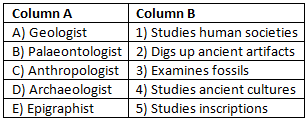Worksheet Solutions: Timeline and Sources of History | Social Studies (SST) Class 6 PDF Download
| Table of contents |

|
| Multiple Choice Questions (MCQs) |

|
| Fill in the Blanks |

|
| True or False |

|
| Match the Following |

|
Multiple Choice Questions (MCQs)
Q1: Who studies the physical features of the Earth?
(a) Archaeologists
(b) Anthropologists
(c) Geologists
(d) Palaeontologists
Ans: (c) Geologists
Q2: What calendar is most widely used today?
(a) Gregorian Calendar
(b) Hindu Calendar
(c) Chinese Calendar
(d) Jewish Calendar
Ans: (a) Gregorian Calendar
Q3: How long is a millennium?
(a) 100 years
(b) 1000 years
(c) 2000 years
(d) 10 years
Ans: (b) 1000 years
Q4: What is a panchanga?
(a) A type of ancient tool
(b) A method of storytelling
(c) A traditional Indian calendar
(d) A historical document
Ans: (c) A traditional Indian calendar
Q5: Which source is NOT commonly used by historians for recent history?
(a) Fossils
(b) Electronic media
(c) Newspapers
(d) Television
Ans: (a) Fossils
Fill in the Blanks
Q1: A _______ is a period of 100 years.
Ans: Century
Q2: The study of ancient inscriptions is done by _______.
Ans: Epigraphists
Q3: The _______ Age was a time when much of the Earth was covered with ice.
Ans: Ice
Q4: _______ are impressions of plants or animals found in layers of soil.
Ans: Fossils
Q5: _______ refers to a life that begins after death.
Ans: Afterlife
True or False
Q1: The Gregorian calendar is used primarily for religious purposes.
Ans: False
Q2: A millennium is 100 years long.
Ans: False
Q3: Archaeologists study ancient artefacts and remain.
Ans: True
Q4: The 21st century CE includes the years from 2001 to 2100.
Ans: True
Q5: Early humans lived in permanent structures and did not move around.
Ans: False
Match the Following
 Ans:
Ans:

|
67 videos|386 docs|80 tests
|
FAQs on Worksheet Solutions: Timeline and Sources of History - Social Studies (SST) Class 6
| 1. What are the primary sources of history? |  |
| 2. How can timelines help in understanding history? |  |
| 3. What is the importance of secondary sources in historical research? |  |
| 4. How do historians determine the credibility of sources? |  |
| 5. Why is it important to differentiate between primary and secondary sources? |  |

|
Explore Courses for Class 6 exam
|

|

















